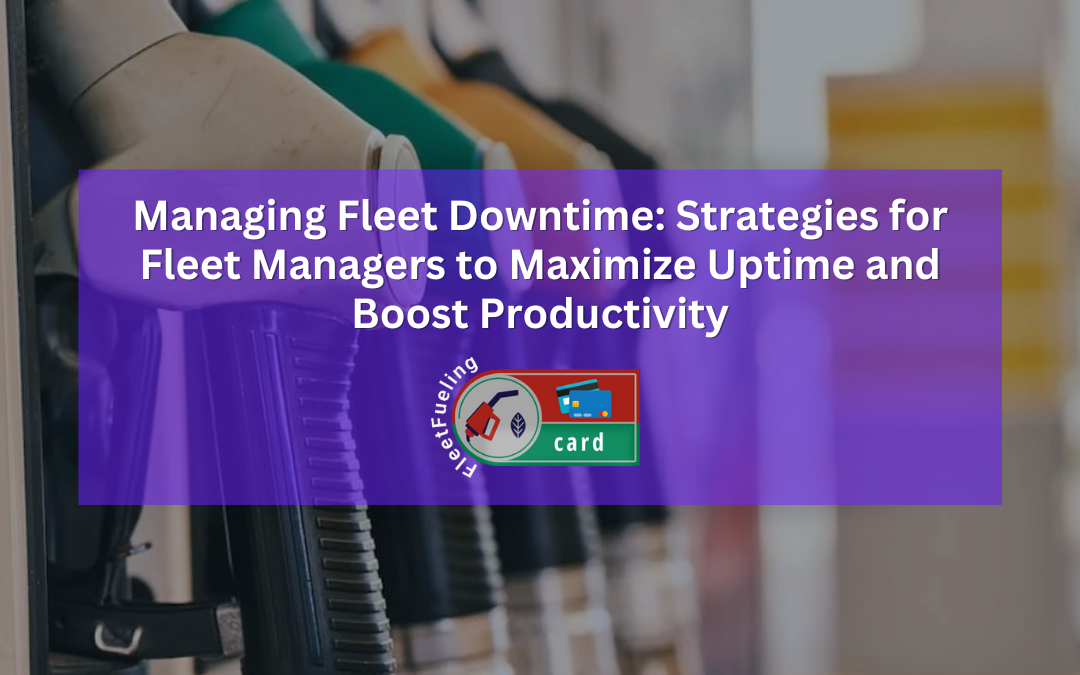One of the biggest challenges fleet managers face is minimizing downtime and keeping their fleet operational. Vehicle downtime can lead to delayed deliveries, missed service appointments, decreased productivity, and ultimately lost revenue. While some downtime is inevitable due to scheduled maintenance, the key to improving fleet performance lies in managing and reducing unplanned downtime.
In this article, we will explore effective strategies that fleet managers can implement to minimize downtime, improve fleet reliability, and ensure the continuous operation of their fleet. From proactive maintenance programs to utilizing the latest technology, these strategies will help fleet managers maximize uptime, improve vehicle longevity, and maintain a high level of operational efficiency.
Why Fleet Downtime is Costly and How It Affects Fleet Operations
Downtime is one of the most significant contributors to increased operational costs. When a vehicle is out of service—whether due to breakdowns, maintenance, or accidents—it cannot generate revenue, making it a direct cost to the business. Furthermore, when multiple vehicles experience downtime, it can cause delays across the entire fleet, impacting deliveries and service appointments, and ultimately reducing customer satisfaction.
The cost of downtime includes not only the lost revenue from the vehicle’s inability to perform its tasks but also the cost of repairs, parts, and labor. Additionally, unplanned downtime can result in more significant damage to the vehicle, leading to higher repair costs and even the need for vehicle replacements.
For fleet managers, reducing downtime is critical for maintaining high levels of productivity and profitability. By implementing strategies that minimize both scheduled and unscheduled downtime, fleet managers can improve their bottom line and ensure that their fleet continues to perform at its best.
Proven Strategies to Minimize Fleet Downtime
-
Implement a Preventive Maintenance Program
One of the most effective ways to reduce downtime is through a proactive preventive maintenance (PM) program. Preventive maintenance involves regular inspections and servicing of vehicles to identify and address potential issues before they lead to major breakdowns. By catching problems early, fleet managers can prevent unexpected downtime and ensure vehicles remain in optimal operating condition.
Key tasks in a preventive maintenance program include:
- Routine oil changes and fluid checks: Ensuring that the vehicle’s engine and systems remain well-lubricated is crucial for preventing mechanical failures.
- Tire inspections: Checking for proper tire pressure and tread wear to reduce the risk of blowouts or poor traction.
- Brake inspections: Regularly checking brake components to avoid failures and ensure vehicle safety.
- Battery checks: Maintaining the battery and electrical system to avoid unexpected failures during operation.
By scheduling regular maintenance and addressing small issues before they become big problems, fleet managers can keep vehicles on the road longer, reduce the need for emergency repairs, and improve overall fleet uptime.
-
Use Telematics for Real-Time Vehicle Monitoring
Telematics technology has revolutionized fleet management by providing fleet managers with real-time data on vehicle health, driver behavior, and location. By implementing telematics systems, fleet managers can continuously monitor the condition of their fleet, allowing them to identify issues before they lead to costly downtime.
Telematics systems can track a variety of metrics, including:
- Engine performance: Monitoring engine temperature, oil pressure, and fuel efficiency can help identify issues that may lead to engine failure.
- Battery status: Monitoring battery voltage can help prevent vehicles from breaking down due to electrical issues.
- Tire pressure and wear: Telematics systems can alert fleet managers when tire pressure is low or when tires are due for replacement, reducing the risk of tire-related breakdowns.
With real-time data at their disposal, fleet managers can make informed decisions about which vehicles need attention, allowing for timely maintenance and reducing the likelihood of unexpected downtime. Telematics also helps fleet managers track maintenance schedules, ensuring that each vehicle receives the appropriate service at the right time.
-
Implement Effective Fleet Scheduling and Route Optimization
Inefficient scheduling and routing can contribute to unnecessary downtime by increasing vehicle wear and reducing fuel efficiency. Fleet managers can minimize downtime by optimizing routes and schedules, ensuring that vehicles are used efficiently and that drivers spend less time idling or stuck in traffic.
Route optimization software uses real-time data to adjust routes based on traffic conditions, road closures, and delivery schedules. This helps ensure that drivers take the most efficient paths, reducing the time spent on the road and lowering fuel costs. Furthermore, optimized scheduling ensures that vehicles are used effectively, preventing unnecessary idle time and reducing wear and tear on the vehicles.
By minimizing the amount of time each vehicle spends on the road, fleet managers can increase the lifespan of the vehicles and reduce the frequency of breakdowns and maintenance needs, leading to less downtime and better fleet performance.
-
Establish a Mobile Fleet Maintenance Program
Unplanned downtime often occurs due to the need for emergency repairs when a vehicle breaks down on the road. Fleet managers can minimize the impact of these issues by having a mobile maintenance program in place. This program involves sending technicians to the location of a vehicle that has broken down or needs repairs, instead of towing the vehicle to a shop for repairs.
Mobile maintenance services can include routine inspections, tire changes, fluid checks, and minor repairs, allowing vehicles to get back on the road more quickly. This reduces downtime significantly, as vehicles can often be repaired on-site or while still in service. Having a fleet of mobile technicians available for repairs ensures that minor issues don’t escalate into major problems that cause extended downtime.
-
Track and Manage Spare Parts Inventory Effectively
Another key strategy for minimizing downtime is to have a well-managed inventory of spare parts. Delays in receiving critical parts for repairs can prolong downtime, especially if vehicles require hard-to-find or expensive components. By proactively managing spare parts inventory, fleet managers can ensure that the necessary parts are always available when needed.
Fleet managers should establish a system for tracking spare parts and reorder items before they run out, ensuring that repairs can be completed quickly without delays. This is particularly important for parts that wear out frequently, such as tires, batteries, and brake pads.
Utilizing fleet management software to track inventory and automatically place orders for commonly used parts can reduce delays and minimize downtime. Additionally, fleet managers can negotiate with suppliers for faster delivery times, ensuring that replacement parts are available whenever they are needed.
-
Develop a Driver Safety and Maintenance Training Program
A well-trained driver is less likely to cause damage to the vehicle or contribute to unnecessary downtime. Fleet managers can reduce downtime by investing in driver safety and maintenance training programs to ensure that drivers understand how to handle their vehicles properly and how to identify early signs of mechanical problems.
Driver training programs should include:
- Basic vehicle maintenance: Teaching drivers how to perform simple checks, such as tire pressure and fluid levels, can prevent issues from worsening during operations.
- Safe driving practices: Encouraging drivers to avoid harsh braking, rapid acceleration, and high-speed driving reduces wear and tear on the vehicle, leading to fewer mechanical failures and less downtime.
- Early detection of issues: Training drivers to recognize the signs of mechanical failure, such as unusual noises or warning lights, can help prevent breakdowns by addressing problems early.
With well-trained drivers who understand the importance of proper vehicle care, fleet managers can reduce the number of preventable breakdowns and ensure that vehicles remain on the road for longer periods of time.
Conclusion: Minimizing Fleet Downtime for Optimal Efficiency and Profitability
Fleet downtime is costly, but with the right strategies in place, fleet managers can minimize its impact and improve the overall efficiency of their fleet. By implementing proactive preventive maintenance, leveraging telematics for real-time monitoring, optimizing routes and schedules, and investing in mobile maintenance services, fleet managers can ensure that their fleet remains operational and productive.
A well-maintained fleet with minimal downtime not only increases profitability but also improves customer satisfaction by ensuring timely deliveries and service. By taking a proactive approach to managing fleet downtime, fleet managers can extend the lifespan of their vehicles, reduce operational costs, and keep their business running smoothly.
With careful planning, the use of technology, and a focus on driver training and safety, fleet managers can keep their fleet performing at its best, achieving higher levels of productivity, reliability, and profitability.


**mind vault**
mind vault is a premium cognitive support formula created for adults 45+. It’s thoughtfully designed to help maintain clear thinking
**prostadine**
prostadine is a next-generation prostate support formula designed to help maintain, restore, and enhance optimal male prostate performance.
**sugarmute**
sugarmute is a science-guided nutritional supplement created to help maintain balanced blood sugar while supporting steady energy and mental clarity.
**gl pro**
gl pro is a natural dietary supplement designed to promote balanced blood sugar levels and curb sugar cravings.
**zencortex**
zencortex contains only the natural ingredients that are effective in supporting incredible hearing naturally.
**mitolyn**
mitolyn a nature-inspired supplement crafted to elevate metabolic activity and support sustainable weight management.
**prodentim**
prodentim an advanced probiotic formulation designed to support exceptional oral hygiene while fortifying teeth and gums.
**yusleep**
yusleep is a gentle, nano-enhanced nightly blend designed to help you drift off quickly, stay asleep longer, and wake feeling clear.
**vitta burn**
vitta burn is a liquid dietary supplement formulated to support healthy weight reduction by increasing metabolic rate, reducing hunger, and promoting fat loss.
**synaptigen**
synaptigen is a next-generation brain support supplement that blends natural nootropics, adaptogens
**nitric boost**
nitric boost is a dietary formula crafted to enhance vitality and promote overall well-being.
**glucore**
glucore is a nutritional supplement that is given to patients daily to assist in maintaining healthy blood sugar and metabolic rates.
**wildgut**
wildgutis a precision-crafted nutritional blend designed to nurture your dog’s digestive tract.
**pinealxt**
pinealxt is a revolutionary supplement that promotes proper pineal gland function and energy levels to support healthy body function.
**energeia**
energeia is the first and only recipe that targets the root cause of stubborn belly fat and Deadly visceral fat.
**boostaro**
boostaro is a specially crafted dietary supplement for men who want to elevate their overall health and vitality.
**prostabliss**
prostabliss is a carefully developed dietary formula aimed at nurturing prostate vitality and improving urinary comfort.
**potentstream**
potentstream is engineered to promote prostate well-being by counteracting the residue that can build up from hard-water minerals within the urinary tract.
**breathe**
breathe is a plant-powered tincture crafted to promote lung performance and enhance your breathing quality.
**hepatoburn**
hepatoburn is a premium nutritional formula designed to enhance liver function, boost metabolism, and support natural fat breakdown.
**hepatoburn**
hepatoburn is a potent, plant-based formula created to promote optimal liver performance and naturally stimulate fat-burning mechanisms.
**cellufend**
cellufend is a natural supplement developed to support balanced blood sugar levels through a blend of botanical extracts and essential nutrients.
**prodentim**
prodentim is a forward-thinking oral wellness blend crafted to nurture and maintain a balanced mouth microbiome.
**flowforce max**
flowforce max delivers a forward-thinking, plant-focused way to support prostate health—while also helping maintain everyday energy, libido, and overall vitality.
**neurogenica**
neurogenica is a dietary supplement formulated to support nerve health and ease discomfort associated with neuropathy.
**revitag**
revitag is a daily skin-support formula created to promote a healthy complexion and visibly diminish the appearance of skin tags.
**sleeplean**
sleeplean is a US-trusted, naturally focused nighttime support formula that helps your body burn fat while you rest.
**memory lift**
memory lift is an innovative dietary formula designed to naturally nurture brain wellness and sharpen cognitive performance.
yinqrdmzi olhxq gbqxxva ocan spgfowcrgtcfikh